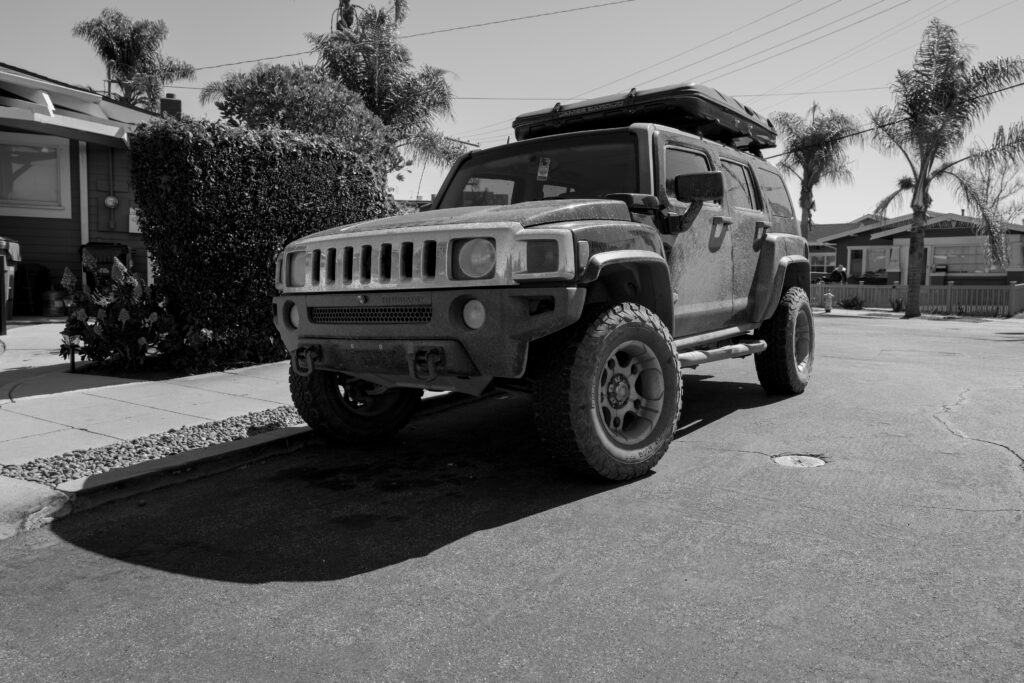San Diego changes around me, particularly from the cost-of-living increases brought by the ever-growing emigration of high-tech workers escaping Northern California; they’re well-paid and find here comparatively affordable rents and home prices—all of which rise as more Googler-types relocate. SARS-CoV-2 (severe acute respiratory syndrome Coronavirus 2)/COVID-19 lockdowns set them free to work from anywhere there is reliable Internet.
So I was only modestly surprised to see a Hummer parked off of Lincoln in the University Heights neighborhood on Feb. 21, 2021. What amazed me more, when arriving here in October 2007, was the number of Hummers seen seemingly everywhere. You could have played an adapted Punch Buggy—and lost—for the few non-military Hummers traveling about the Washington, D.C. metro area that we left nearly 14 years ago. In San Diego, the contrast was stark, and I wondered why all the gas guzzlers given stereotypes about carbon-aware, environmentally-focused California culture. Should I answer status symbol? The late-2008 economic collapse purged the oversize vehicles from local roadways. Who could afford higher monthly payments or gasoline for a roadster rated city driving of 13 miles to-the-gallon? By mid-2009, their numbers had diminished to near nothing; that I observed. Eventually, as the economy recovered, based on increasing sightings, various Jeep models replaced the Hummers as all-around utility vehicles.
Newcomers
Pandemic-driven relocation is transforming University Heights and presumably other San Diego County communities. I started seeing stark demographic changes here by late-May 2020 that continue:
- More young professional types out and about
- An increase in the number of younger couples
- Lots more parents strolling along very young children
- A sudden surge in the number of residents who are black
The last point matters to me because of where we lived before. Compared to other regions of the country, D.C. has a relatively large African American population (47.1 percent). Upon arrival, more than 13 years ago, I found San Diego to be uncomfortably white; by comparison. According to (outdated) demographic data provided by the city: 56.7 percent, White; 30.3 percent, Hispanic; 17.3 percent, Asian; 6.5 percent, Black. I admit to an acute awareness of black folks, as such, and relief in seeing their numbers apparently increase in my neighborhood. Diversity is good.
Housing
Five years ago—even 18 months ago—I would have described University Heights as a community of older home owners and younger renters. But soaring property values has incentivized many established residents to sell—and buyers must be of more than modest means to do so. Capitalism 101: Demand drives up prices. Currently, the lowest listed residence for sale in my neighborhood is a 1,250 square-foot, two-bedroom townhome for $649,900. Plunk down 20 percent ($129,980), snag a lower-interest mortgage (2.82 percent), and pay $2,929 per month (including HOA fee and taxes). Up the interest rate to 3.5 percent and pay $3,122 monthly. Maybe that’s a winning-the-lottery opportunity for Silicon Valley immigrants, but a burden to many locals in a city where median, annual household income is $71,535 (BestPlaces data).
Rising rents are bringing in wealthier tenants (e.g., younger professionals and well-paid couples with children) and driving out singles or couples working in, say, hospitality. The currently lowest-rent 2-bedroom apartment larger than 800 square feet is $1,850 per month. That’s a bargain.
Lifestyle
Other changes observed among my new neighbors:
- More bikers and runners (sometimes in groups)
- More evidence of people doing sporting, water, or off-road activities
- More entrepreneurs creatively running lifestyle businesses from their residences
The keyword for all three is active. Healthy-lifestyle would be another. Example of the third point: One of my newest neighbors, who recently bought a small house for $720,000, rents out a large camper van. Think of it as an Airbnb RV. The thing is rarely parked in the driveway, if that’s any sign of demand.
The second point brings us, finally, to the Featured Image (warning 22MB file), which I captured using Leica Q2 Monochrom. Vitals, aperture manually set: f/5.6, ISO 200, 1/500 sec, 28mm; 12:07 p.m. PST. Photo is composed as shot but edited to taste. The vehicle was dark (grey, perhaps), making black-and-white work well (or so I say).
The lone Hummer is a metaphor for the neighborhood’s changing demographic: Tech professional, entrepreneurial, diverse, younger, well-paid, and active. The vehicle had clearly been off-road in the mud somewhere. I really should have taken a back-end view of the massive backpack hanging from the spare tire affixed to the rear door. Muddied and rugged, over-sized and gas-guzzling, pricey purchased new: The thang is a lifestyle symbol. Yes, I have seen more than the one. Expect a sales rush when the Hummer EV (e.g., electric) is available later this year. Hehe, you can reserve one now.
Update, Feb. 24, 2021: That $649,900 townhouse is sale pending for $712,500—$62,600 over asking price. The place previously sold for $579,000 on Aug. 4, 2017. That’s a 23-percent increase in about 3.5 years.
